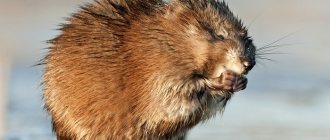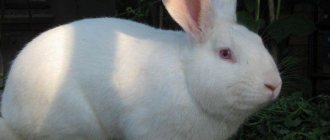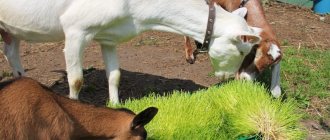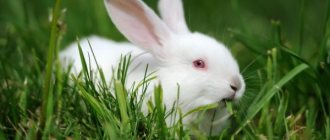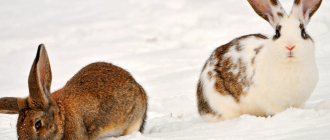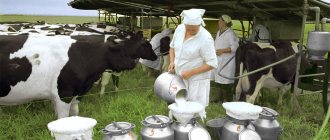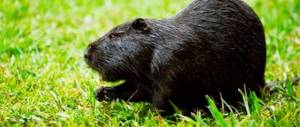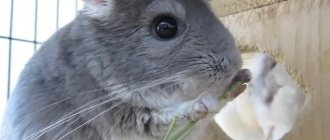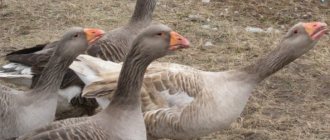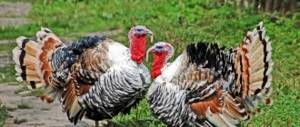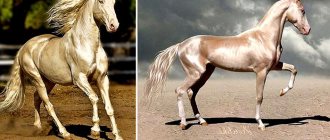Rabbits of the Risen breed are kind, affectionate animals. They have a high fertility rate. They can be bred in pits, enclosures, and spacious cages. These animals are distinguished by their good-natured and affectionate character.
Breed Features:
- The main feature of the breed is their size;
- Natural characteristics can persist up to 4 generations;
- The interval between births is 8 months instead of the standard 3-4;
- Individuals are clumsy and clumsy.
Origin story
Photo:
The history of the Riesen breed can be traced back to the 16th century, when a breed of local rabbits with dense gray skin and a heavy weight of 5-6 kilograms was described in Flanders.
At the end of the 19th century, the Belgian giant, as it was then called, came to Germany. German rabbit breeders enthusiastically began breeding Flemish giants and developed their own line, focusing on the weight of the animals.
In 1937 the breed was registered under the name "Deutsche-Riesen", which means German giant. So the Belgian became a German.
Today, there is no consensus among rabbit breeders and breeders: some believe that Risen rabbits are an independent breed, others argue that Risen is just a slightly larger variety of the Great Flanders.
Where to buy rabbits and their cost
German Rizens are bought in specialized nurseries. There is no need to buy animals from pet stores or from others. Before purchasing, be sure to inspect the animal. You will have to refuse the purchase if the animal bites and shows aggression. This suggests that there are other admixtures of rocks. The price for one animal ranges from 1000 rubles. The seller must have documentation for German giants, which indicates the name of the subspecies, information about vaccinations, weight, and age.
Description of the breed
Characteristic:
- Animals have an elongated body, reaching 75 cm;
- The head and cheeks are powerful;
- The ears are dense, erect, reaching 20 cm;
- The chest is massive and large. The girth reaches more than 40 cm;
- The limbs are large and muscular;
- The weight of the ears varies between 8-15 kg;
- The hairline is thick, shortened, reaching no more than 4 cm;
- The shade of the fur is different. There are black, snow-white, natural, silver, blue, sand shade;
- The eyes are brown.
- The front legs are massive, widely spaced to support the weight of the body.
Age table:
- Age: 1 day, body weight, kg - 0.9;
- Age: 1 month, weight - 1.2;
- 2 months - 3.2 kg;
- 3 months - 5 kg;
- 4 months - 6.4;
- 5 months - 7.0;
- 6 months - 7.6;
- 7 months - 8.2;
- 8 months - 9 kg;
- 9 months - 10 kg.
Risen rabbits are theoretically classified as meat-hide breeds. Their fur is 4 cm long.
Colors
Initially, the colors determined by the agouti gene predominated among the German Riesens. That is, zone-gray and zone-red. White is a spontaneous mutation of the genes responsible for color.
The inconspicuous “hare” color was the main obstacle to the use of this breed for the manufacture of fur products, although the large skin is of greater interest to furriers than the skins of smaller rabbits.
The situation was corrected when Risen rabbits of blue and black colors were bred.
Standard color:
Blue color:
Black:
The standard also allows a red color, which on Russian-language sites can be called “gold”, using tracing paper from the English language.
When searching for Rizens based on an ad, you must take into account that the exotic “gold” is just a red rabbit and its productive characteristics are no different from other rabbits of this breed that have a different coat color.
Ginger:
The calm and easy-going nature of German Risen cats allows them to be kept as pets.
Productivity
Before the appearance of representatives of the breed, whose color differed from the natural dark gray, Risen rabbits were very reluctantly used for the manufacture of fur products. The main emphasis was placed on obtaining meat. However, after the appearance of alternative colors, the interest of breeders in the furs of these animals increased noticeably. In addition, the skins of larger individuals are traditionally valued more highly than the skins of miniature rabbits.
With proper feeding of Rizenov, you can get excellent quality dietary meat from them.
How to choose a breeding rabbit?
It is necessary to select babies from the spring births. Preferred months: February-March. During this period, the cubs receive the best nutrition. Required age for purchase: 3-4 months.
At this time, it is possible to weed out defective and unhealthy animals based on physical indicators.
To raise a breeding stock, you need to buy young animals from spring litters. Rabbits born in the spring had the opportunity to receive maximum vitamins and nutrients.
Although some believe that winter litters are stronger and better suited for breeding use, although the animals from these litters grow smaller than their spring and summer counterparts.
It is best to take 4-month-old rabbits from a breeding farm with a good reputation.
When choosing a baby rabbit, you need to take a closer look at its behavior and appearance. Although, according to the description of the breed, Rizens are very calm animals, nevertheless, a rabbit that is too motionless should alert you. If at the same time the animal tries to hide under a wall or hide in a corner, it is better not to take rabbits from this litter at all.
Upon external examination, the baby rabbit should be “smooth”, meaning there should be no bones sticking out under the skin. If the owner claims that the animal is thin because it is growing, it is better to buy breeding stock from another farm. But the baby rabbit shouldn’t be too fat either.
The fur of a healthy animal lies evenly on the body and usually makes you want to stroke it. Dishevelment indicates health problems. The eyes should be clean and shiny, and there should be no discharge from the nose.
Advice! When choosing a rabbit, you should carefully examine the inner surface of the front legs.
If there is matted fur on the paws, it means that the rabbit was cleaning its eyes or nose with its paws. You should not buy such an animal.
A smooth, wide back and smooth, powerful paws will indicate the absence of rickets. Rabbits should also have a wide croup.
It's also worth looking into the mouth. It is better not to buy a baby rabbit with an incorrect bite. Such an animal will soon begin to have problems with its teeth and, as a result, with eating and assimilation of food.
Vaccinations
Animals are allowed to be vaccinated from two months of age. It is better to inject subcutaneously or intravenously. The ideal time for vaccination is spring. The vaccine is given to healthy individuals without signs of disease. Initially, the baby rabbit is vaccinated against VGBV, and after 2 weeks - against myxomatosis. Further, it is recommended to repeat vaccinations against VGBV and myxomatosis. It is important to remember that a break of at least 2 weeks is required between vaccinations.
See also Features of breeding Rex rabbits
Breeding
The German Risen is a late-maturing rabbit. If meat breeds can be mated as early as 5 months, then with Risen you will have to wait up to 8-9 months.
Due to their late maturation, giants are now losing ground to broiler, early-maturing rabbit breeds. On average, a female rabbit brings the same number of babies as smaller breeds.
At the same time, young females have small litters, to the point that they can give birth to only one baby rabbit.
There are 5-6 female rabbits per male. With a larger number of females, fertility may decrease.
After mating, the rabbits are transferred to an enhanced diet. If there is a lack of minerals, feed of animal origin is added to the feed, as well as chalk and feed phosphates. In winter, the diet must contain tricalcium phosphate, 5 g per head per day.
Growing conditions
Representatives of this breed are not very adapted to Russian climatic conditions. To keep them comfortable, they will need to be equipped with insulated cages. Also, if possible, it is recommended to equip cages in the rabbitry, in which the microclimate can be regulated, for example, by installing heaters.
The cage should be spacious, twice as large as for ordinary rabbits. For females with cubs, an even larger cage is needed. Its height must be at least 65 centimeters. Such conditions are suitable for keeping individual animals for meat production.
When keeping a breeding herd, it is recommended to equip individual enclosures; their total area should be at least 1.5 square meters.
Because these rabbits are overweight, they often suffer from the development of corns or pododermatitis as a result of injuries to their limbs on the slatted floor. To prevent such a disease, it is recommended to always lay a layer of bedding on the bottom of the cage. With its help, the animals will feel comfortable. In this case, it will be necessary to clean the cage rooms much more often.
Experienced rabbit breeders suggest building a special tray that will slide out. A layer of bedding is placed on it, which can be removed from the cage room.
An ordinary cage will need to be modified specifically for raising these animals. Due to such conditions, many rabbit breeders prefer to raise their pets in special enclosures. If you keep it in such a room, cleaning it will be much easier. It is enough to temporarily move the animal from the enclosure, and then remove the layer of dirty bedding with a shovel.
Experienced rabbit breeders recommend not just laying a layer of hay, but first adding a layer of sawdust and sprinkling hay on top. In such conditions, animals will be more comfortable for the following reasons:
- the hay will be dry;
- feces will be absorbed by the sawdust that is under the hay layer.
Such an enclosure is cleaned as it becomes dirty, but at least once every two days, otherwise the animals will stain their six, skin and paws with droppings, and this is fraught with the development of various skin diseases. After the bedding layer is removed, the cage or enclosure is treated with disinfectants.
Content
Many rabbit breeders refuse to keep this subspecies for several reasons:
- Cages, pens or enclosures take up a lot of space;
- For full cultivation you will need a lot of feed;
- Animals of this subspecies are prone to obesity;
- Despite the high fertility, the interval between births should be at least 8 months.
Cell requirements
Rabbits of the Risen breed are very thermophilic. Because of this, it is recommended to choose an eastern or southern direction for the cultivation room or place for the construction of cells.
The cages in which the eared beetles will live should be made 3-4 meters wider. This way the giants will have space to move freely. The floor can be mesh or horizontally flat.
The fastening areas should be covered with a heavy mat or durable plastic sheeting. Sawdust, straw or coarse sea sand are poured on top.
Such materials will help not injure the paws of the eared animals. Hay is also scattered in the corners. It is necessary for the giant to use it as bedding. Feeders are nailed to the edges of the cage.
Climatic conditions and temperature conditions for breeding
When raising eared animals, it is necessary to take care of cooling the animal pen in hot weather.
Temperatures above 48°C cause mass death of eared beetles. At this temperature, it is necessary to place chilled bottles of water and ice around the perimeter of the home.
You will also need a shade awning over the rabbit pen. In hot weather, it is necessary to carefully monitor the availability of fresh drinking water in the animals' bowls.
What else?
It is better to keep the breeding herd in individual enclosures with a floor area of 1 - 1.5 m².
When keeping shad, bedding for rabbits is usually not provided, except for queen cells. But due to their heavy weight, Risen too often get so-called “corns” - pododermatitis, damaging the soles of their paws on the floor grating.
Therefore, for giants, the presence of hay bedding in the cage is a prerequisite for the proper maintenance of this breed of rabbit. But then the function of the lattice through which the rabbit droppings falls out of the cage is lost.
You can make a special retractable tray on which the bedding will lie and which can be removed from the cage. But this will require reworking ordinary cells for Risen.
For this reason, it is often convenient to simply keep giants in an enclosure, where it is enough to remove the rabbit from its premises and then remove all the dirty bedding with a shovel.
If you put sawdust under the hay, then the rabbits will sit on dry hay, since the urine will be absorbed into the sawdust lying under the hay.
You need to clean such enclosures as needed, but do not delay this procedure, as otherwise the rabbit will trample the pellets of droppings and will live on manure, as in the photo, and this adversely affects the condition of the fur and skin on the animal’s paws.
After removing the bedding, the cage must be disinfected.
Diseases and prevention
It also happens that rabbits get sick. Most often, due to the inattention or irresponsibility of their owners. Below is a list of the most common diseases among animals.
A healthy rabbit has smooth fur, good weight, and a strong and long body.
Common diseases
Common diseases include:
- Coccidiosis. This disease literally eats away the rabbit’s digestive system, causing it to subsequently die;
- Myxomatosis. Rash and ulcers appear on the body. This is a consequence of the fact that the disease has affected the animal’s digestive system;
- Infectious stomatitis. This disease occurs in the oral cavity. Because of this, rabbits refuse to eat. Soon they die of hunger;
- Rhinitis. It occurs because the rabbit is exposed to wind and drafts. Most often, it occurs due to non-compliance with temperature and climatic conditions;
- Pasteurellosis. This is an infection that can cause the death of all newborn rabbits.
Diagnosis of diseases
First of all, pay attention to the external condition. A healthy rabbit has good weight, smooth fur, and a strong and long body.
How to check the health of an animal
If a rabbit develops a rash, begins to eat poorly or refuses to eat at all, then these are the first alarm bells. It is worth contacting a veterinarian or other specialists for a more accurate diagnosis.
Prevention of diseases of the Risen breed
To prevent animals from getting sick, you should think about a vaccine. Rabbits initially have weak immunity. To increase their chances of survival, you should consider vaccinations . They will not give a 100% guarantee that the animal will not get sick. But it will increase the chances of success.
Vaccination
At first, the cubs are protected by mother's milk. Or rather, the antibodies are in it. But, they are valid only for the first six months. After which you need to get vaccinated:
- The first vaccination rabbits receive is against rabbit viral hemorrhagic disease, or RVHD. It is carried out a month and a half after the baby rabbits are born.
- The second vaccination is against myxomatosis. It must be performed when 2 weeks have passed since the previous one.
- Next, repeated vaccination against VGBV is carried out. If the animal’s condition is good, then it is carried out after 2-3 weeks.
- After the same period of time, repeated vaccination against myxomatosis is done.
The minimum weight of a rabbit for breeding is 8 kg
Feeding
Rizens eat the same food as other breeds of rabbits, but it must be taken into account that all feeding standards in the tables are based on rabbits weighing 4-5 kg. For Risen, the amount of feed increases in proportion to its weight.
Ideally, it would be rational to use complete factory-made food for rabbits for Risen, since these foods are balanced in vitamins and minerals, plus they do not cause bloating, which can be obtained by feeding succulent food from the garden to rabbits.
The disadvantage of these feeds is that few people produce them in Russia, except for imported feeds for decorative rabbits in pet stores.
Therefore, when raising rabbits for meat, you either have to make feed for them yourself or feed them grain. In addition to hay and grain feed, rabbits can be fed succulent feed. But it is succulent food that causes digestive problems in rabbits, so they must be fed carefully.
Important! The rabbit's diet should not include fresh white cabbage.
When you create your own diet, it is difficult to balance it with vitamins and minerals. But you need to know that most vitamins are produced in the rabbit’s intestines by the bacteria living there, so in the absence of dysbacteriosis, the rabbit almost does not need vitamins.
The table shows the vitamins that are produced in the rabbit’s intestines:
In case of dysbiosis, for example, during a course of antibiotics, these vitamins must be added artificially and restore the microflora in the rabbit’s intestines as quickly as possible.
Three vitamins, although essential, are not produced: A, D, E.
Vitamin A is responsible for regulating the reproductive and nervous systems, as well as physical development. Can accumulate in the liver.
Hypervitaminosis symptoms are similar to signs of poisoning. Contrary to the belief that red vegetables contain the most vitamin A, fresh nettle contains more of it than carrots.
Comment! Nettle contains even more protein than alfalfa, which is undesirable for adult rabbits due to the risk of obesity.
Vitamin E is necessary for the development of muscle mass, the reproductive system and the normal functioning of the cardiovascular system.
Vitamin D prevents the development of rickets and promotes proper bone development. But we must take into account that hypervitaminosis of vitamin D causes calcium deposition on the walls of blood vessels.
Even with an increase in the diet, the proportions of food for Risen rabbits remain the same as for other breeds. In winter, hay is at least 15%.
You can feed hay up to 25%. Concentrates from 40 to 60%. Juicy feed from 20 to 35%. In summer, hay is often removed, leaving grass, which is usually classified as succulent or green fodder.
In this case, herbs give from 35 to 60% and concentrates from 40 to 65%. Maximum concentrations of concentrates are usually given to fattening rabbits.
Characteristic
German giants are a late-maturing breed. Females become sexually mature by the 9th month, while in other rabbits this period occurs in the fifth month. Risen females are prolific and can bear more than 10 rabbits in one litter.
An adult rabbit weighs about 10 kg, some representatives gain weight up to 14 kg. The yield of meat products is quite high due to the fact that the animals are large. The meat is tender and juicy.
Rizens have a soft, calm character. It is because of this that many people get pets for pets. It is not recommended to purchase German giants for a small child; he may accidentally injure him without even meaning to.
Such large rabbits need to be raised and kept in spacious and capacious cages. For one animal you will need 100x110x70 cm of space, for rabbits with offspring this figure increases - 170x110x50 cm. At the same time, Risen are no different from their smaller counterparts, they love to move.
If there is not enough free space, rabbits become inactive, resulting in problems with excess weight.
If cellular housing is chosen, the floors are covered with plastic or wooden covering to prevent injury to the limbs. Uncoated mesh floors lead to the formation of corns.
An equally important condition is ensuring cleanliness in the cage or enclosure. It is necessary to carry out timely cleaning and change of litter
The rabbitry must be equipped with a good ventilation system. If the air is stagnant and musty, a number of diseases may begin.
The premises in which animals are kept are disinfected every six months. At this time, the rabbits are transferred to another enclosure. Poor living conditions lead to illness and, in some cases, death.
Risen wild color
First of all, it is important to note that Risen rabbits have a rather interesting history of their origin. They first appear in the 15th century
Moreover, at the beginning of their existence, the animals had a slightly different name - they were called Belgian giants. Generally speaking, the breed originated in Flanders, but was later introduced to Germany.
If we talk about the anatomical description of Risen rabbits, then special attention should be paid to the distinctive features of this breed. Thus, animals have a rather massive and wide chest and a long body.
They move thanks to their thick but straight legs. Because of this, many people say that Risen rabbits look a little clumsy. The weight of rabbits usually varies from 6 to 10 kilograms. This indicator is considered the so-called gold standard. However, there are exceptions: record-breaking rabbits belonging to the Risen breed can reach a weight of 14 kilograms.
The dimensions of the rabbit are also surprising. The body length of the animal can reach 75 centimeters, and the chest circumference usually does not exceed 42 centimeters. Among other things, rabbits are distinguished by their large heads and large cheeks. Risen's ears can also be considered record holders in terms of length. Females and males can have ears ranging from 13 to 20 centimeters in length (in rare cases, a length of 25 cm is noted).
